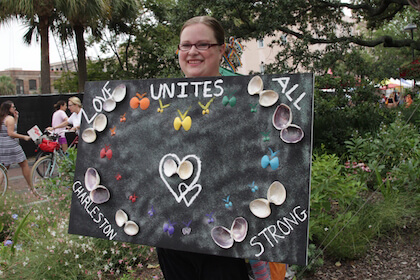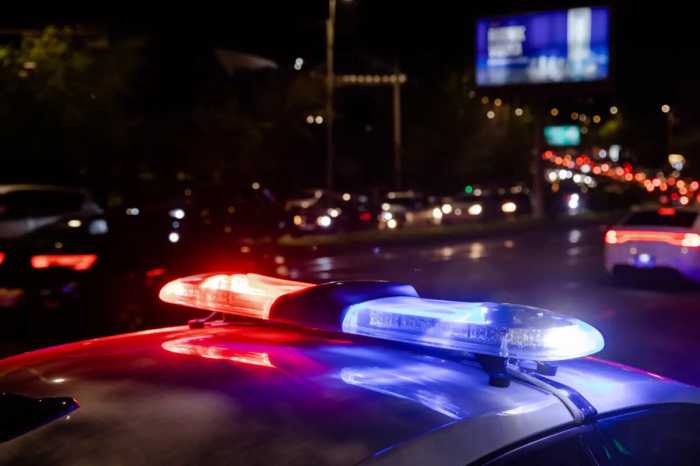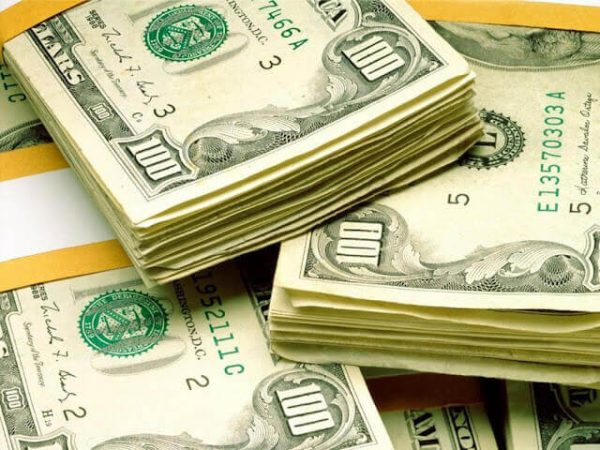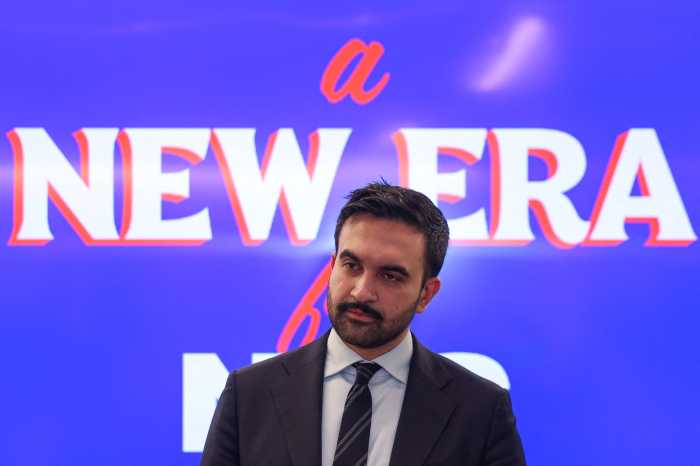COVER STORY ILLUSTRATION BY MICHAEL SHIREY
BY MICHAEL LUONGO | He was a lone wolf, delivering a message of hate to Charleston.
Overhead, he held a giant banner proclaiming “God Hates Pride.” Still, that he was solo on King Street as dozens of floats and hundreds of marchers filed past him might be a sign of Bible Belt progress. Most marchers ignored him, a few got into shouting matches, while others posed with him for selfies, their own banners proclaiming God’s love for all.
Charleston’s Pride is new, formed in 2010 after a smaller pride event moved to the heart of the city from North Charleston’s Park Circle, the metropolitan region’s main gay neighborhood. Whether in Park Circle or downtown, though, Bible Belt sensibilities are never far off. The march was held on a Saturday, a Southern nod, locals told me, to the untouchable holiness of the Christian Sabbath. It was also strikingly full of church participation, certainly the highest percentage I have ever seen in a pride parade, undoubtedly a reflection of the deeply religious nature of Charleston, its skyline a riot of church steeples instead of skyscrapers.
Families with young children added another wholesome touch. There were also the staid, well-built young women and men of the Citadel, a mark of the new gay pride normalcy since Don’t Ask Don’t Tell’s demise.
To be sure, there was plenty of Southern flamboyance, from rainbow fur-decked cars to leather daddies in clothing incongruous in the wilting, 90-degree humidity, more suitable for magnolias than masochism.
Buddy Fischer. | MICHAEL LUONGO
Buddy Fisher, the solo protestor, came from several hours away, and runs a YouTube channel, Buddyfisher1.
“I go to places where there is sin,” said Fisher, who targets not only LGBT events, but also Bourbon Street in New Orleans.
He continued shouting against gays as we walked along King Street, claiming that at least five or six other protestors were also there, though I saw only two, lost within the well-wishers.
It was another lone wolf’s message of hate that went beyond words into a massacre, which brought me to Charleston. On June 17, Dylann Roof stepped into the Emanuel African Methodist Episcopal Church, known as Mother Emanuel, one of America’s most important historically black churches, and murdered nine church members in the downstairs community room, including senior pastor Reverend Clementa Pinckney, who was also a South Carolina state senator.
Pinckney’s murder meant — among so many things — that LGBT South Carolinians lost a political ally. Though he had voted against same-sex marriage, through his work on the South Carolina Legislative Black Caucus, Pinckney was regarded as a progressive fighting against other forms of anti-gay discrimination.
Memorial tributes left outside the Emanuel African Methodist Episcopal Church, known as Mother Emanuel. | MICHAEL LUONGO
Southern Pride in a Small City
Gay City News doesn’t normally cover small Southern pride celebrations, but I viewed the timing of Pinckney’s death so close to Charleston Pride Week (which ran Saturday July 25 through the parade and festival the following Saturday, August 1) as a reason to visit.
I had not been to Charleston in 25 years, but grew curious about its LGBT community while writing an article for a major mainstream travel glossy on Southern states that had legalized same-sex marriage ahead of the Supreme Court ruling — a group that included South Carolina. The article was delayed in anticipation of the Supreme Court ruling — and ultimately cancelled following the shootings — but I learned of efforts to make Charleston a major gay wedding destination center. These included the new Beau Magazine, published by Maria Rivers, which had a popular wedding issue, its cover graced by an interracial transgender couple. Timed for Charleston’s Pride was also Get Hitched Charleston, a gay wedding expo planned by straight couple and local events gurus Thomas and Becky Smith.
Charleston is already one of America’s most important destination wedding centers, partly as a legacy of slavery. The city is ringed by antebellum plantations, many now used for weddings, a surprise to me as a northerner who associates them with brutality, not marital bliss.
Important in both the Revolutionary War and the Civil War, which began in the city’s harbor at Fort Sumter, a tremendous pride exists among locals about the city’s special place in history. Rob Lewis, former chair of Charleston Pride Festival, Inc., speaking of Charlestown at the Pride afterparty in the historic Memminger Auditorium, told me, “We tend to call it the jewel of the state.” The city’s love of art and culture, he added, “draws a lot of people who are more progressive, so it makes our LGBT community more accepted. It’s almost like it’s a non-issue.”
Steve Grand was the festival’s headlining entertainer. | MICHAEL LUONGO
He and Chase Glenn, Pride’s chief operating officer, told me a record 5,000 people attended the parade and festival, with 63 individual groups registered to march. Five hundred people were also at the afterparty, where out gay singer-songwriter Steve Grand was the headline act.
All of this was an indication of how liberal Charleston viewed itself on LGBT and other issues.
Yet with the killings receiving international attention, I wanted to see how the LGBT community was reacting. In this city where roughly 34 percent of the population is African-American and 63 percent is white, I wondered how integrated LGBT groups were. I also wondered how much outreach was done by the group behind the parade, Charleston Pride Festival, Inc., to recognize the tragedy and include the Emanuel AME church in events and programming.
It didn’t rain on Charleston’s gay pride parade, but showers did dampen the festival afterward. | MICHAEL LUONGO
Rainbows in the Rain It didn’t rain on the parade, but it certainly rained on the festival. The soggy grounds were surrounded by tents of LGBT organizations, churches, and groups representing political campaigns, including Hillary Clinton’s, where festivalgoers huddled to escape the rain. This too was a very family-oriented space. In the intermittent hiatuses from rainfall, children, faces tattooed with temporary rainbow flags, gathered near the stage. Local drag personality Patti O’Furniture hosted, reminding performers to behave. (She and others saved foul language for the afterparty.) The raciest comment was a joke about Republican Senator Lindsey Graham — derided by some on the left and the right as a closeted gay man — from out gay local radio personality Mike Edwards, who called him “Miss Lindsey Graham.” “I pick on Lindsey all the time,” Edwards quipped. “We went out a couple times.”
Out LGBT mayoral candidate Ginny Deerin. | MICHAEL LUONGO
Out politician Ginny Deerin had one of the busiest booths. When asked about her sexuality, Deerin said, “I define myself as a proud member of the LGBT Community.” A Democratic mayoral hopeful, she had earlier participated in a Pride Week candidate debate.
Deerin described Charleston as “interesting, and part of that is because we’re diverse, and, it being a port city, we have a history of lots of mixing, lots of different people, lots of different cultures.” She added, “Whether you’re talking about the gay community or the black community or young people or even older black and white people, we like the mix.” Deerin called the LGBT community “a very powerful, robust group” with political power. Saying she had attended Mother Emanuel’s Sunday sermon just before the killing, Deerin recalled she was “maybe the only white person in the congregation.” Because of this, she said, “Reverend Pinckney, he embraced me.” It was the last time she would see him.
State Senator Marlon Kimpson, a headliner at Charleston Pride and a close colleague of the slain Reverend Clementa Pinckney. | MICHAEL LUONGO
Another politician who knew Pinckney was straight, African-American State Senator Marlon Kimpson, a festival headliner. From the stage, he spoke of strong linkages in the fight for equality between the LGBT and African-American communities.
Offstage, Kimpson told me Pinckney was “a giant” in terms of his political impact on LGBT issues. The two worked together in the Senate’s Black Caucus, including fighting to keep Alison Bechdel’s graphic novel “Fun Home,” and the musical it spawned, at local universities.
“In the United States of America, we believe in the bedrock principle of this country that we’re all created equal, and generations have carried this to extend in different ways,” Kimpson said. “The same is true of the lesbian and gay community. They face enormous discrimination from the choice to whom they love, and so it’s a struggle for recognition of having a spouse. I’ll say a struggle for equal access to public accommodations and to be treated equally, and they deserve equal protection under the law, and so in that regard it’s the same.”
Not everyone at the festival felt that there was enough coordination across racial lines. Among them was Dean Edwards, acting vice president of Pride Events for South Carolina Black Pride, an organization based in the state’s capital, Columbia. Originally from Bermuda, Edwards told me he remains surprised by the discrimination he has found in his new country.
Edwards thought more minority representation would ameliorate racial issues within the LGBT community. He was particularly critical of South Carolina Equality, saying, “I don’t think they have any African Americans on their board at this time, and I think that’s become an issue. They went to lots of supporting agencies, and the agencies they serve are saying, ‘What do you know about representation? If you’re about equality, why don’t you have somebody, at least one person, on the board?’” He added, though, that the state’s LGBT organizations still “work together. We come support their event, they’ll come up to our event, but I think we need to come together as a whole and build some more community. When we had our Black Pride [in Columbia], we had Charleston Pride up there, we had South Carolina Pride up there.” He labeled the latter two organizations “white” and added that Black Pride has a white male board member.
South Carolina Black Pride’s Dean Edwards. | MICHAEL LUONGO
Charleston Pride has one mixed-race board member, Topher Larkin, of Thai and Irish descent, and one female board member, Paulette Wendell.
Late June’s Black Pride was also the first South Carolina pride in the immediate aftermath of the shootings. Edwards and Pinckney were Alpha Phi Alpha fraternity brothers at Allen University. Edwards, shaking his head at the loss, said, “He was such a great man, respected in this community and across the state.”
On the seeming dissonance between Pinckney supporting LGBT anti-discrimination laws and simultaneously opposing same-sex marriage, Edwards chalked it up to his being a pastor in “a black AME traditional church,” adding, “Deep down in his heart, he didn’t have any dislike for what the LGBT community does.”
That there could be more inclusion within South Carolina’s LGBT community was borne out in the festival’s crowd make-up. In a city that is one-third African American, fewer than 10 percent of the pride revelers were visibly from communities of color, whether black, Asian, or Latino. Jeff Ayers, South Carolina Equality’s chair, told me, “I think that we have a lot of work to do in reaching out to the African-American faith-based community,” adding, “That’s why South Carolina Equality is forming an African-American task force/ LGBT task force that is made up of nothing more than African-American individuals, activists that are actually going to focus on strategy on how to bring the African-American faith-based community into our LGBT movement.”
Southern speak for everyone is created equal. | MICHAEL LUONGO
Rather than highlighting divisions, Ayers pointed out South Carolina’s progress, from winning marriage equality to removing the Confederate flag from the state capitol grounds. He said, “One group that always, always, 100 percent had the LGBT back is the South Carolina Black Democratic Caucus,” explaining that is why his group stood with them on the flag issue. Still, he added, there is “a lot of work to be done connecting the dots between the LGBT movement and the African-American, faith-based community,” something he said goes both ways, with many African-American church members often not understanding LGBT issues.
Anthony Beckett, president of South Carolina Black Pride, told me by phone that his group and those like South Carolina Equality must “find commonalities that exist and that bring us together.” However, he also said, “This is something I have been arguing about and pleading with them about for two years. You have no one that looks like us on your staff, not in a volunteer capacity or in a paid capacity. When they ask, ‘How can we get more black people, how can we get more African-Americans?,’ I was blunt and very candid: you have to meet them where they are and you have to have someone that looks like them on your team.”
Perhaps partly for these reasons, it was clear to me that Charleston Pride struggled in how to commemorate the deadly shootings and communicate with Mother Emanuel. The group’s Chase Glenn told me that one plan was a moment of silence along the parade route, stopping at the intersection of King and Calhoun Streets, the closest point to Mother Emanuel. However, this was logistically difficult with its location beside Marion Square Park and along two major thoroughfares. Instead, a moment of silence was observed at the festival, announced from the stage. I missed this, perhaps because it was raining and I was under a tent too far away to hear whether silence had in fact descended on the crowd.
Tony Williams and Rob Lewis from Charleston Pride. | MICHAEL LUONGO
In the midst of one of the worst cloud bursts, huddled together inside the VIP tent just offstage, I asked Tony Williams, Charleston Pride’s chief executive officer, whether the organization had directly asked Mother Emanuel to be involved in Pride events. Williams' answer was simply, “No we did not.” He added that, in response to the shootings, the group made an effort to increase the number of churches marching in the parade. When pressed on why other churches were asked to participate in response to the shooting but not Mother Emanuel itself, Williams said, “We didn’t reach out directly. All of it is to make sure they have time to heal. [The shooting] was so close to the festival’s timing.”
Board members of the group, he said, attended vigils for those killed in the shootings, though he did not know of any attending sermons inside of the church. Williams added, “We were devastated immediately after, but seeing everyone come together in the days and weeks after was very inspiring.”
A pride banner serendipitously mounted near Mother Emanuel. | MICHAEL LUONGO
Sunday Sermon A view from the street in Charleston might have given the impression Mother Emanuel was deeply involved in Pride. At the time of my visit, a giant banner straddled Calhoun Street directly in front of its steeple. It was the only public advertisement in the city center about Pride, and to an outsider it looked as though the church had placed it there. Instead, as Williams explained to me, it is coincidentally the city’s only central district public banner location.
The sidewalk surrounding Mother Emanuel is thick with makeshift memorials. Flowers(real and fake ones crafted from palmetto fronds) sprout from vases. Teddy bears, flags, and ribbons adorn the adjacent fences, and enormous boards are affixed to the church’s double front steps where well-wishers have signed their names, many taking selfies as they do so. Though the crowd was mostly African-American, it was the most diverse gathering I had seen in all of Charleston, with locals and tourists alike paying homage to the dead.
At the sermon, I found as always there is no better-dressed place in America than a black church on Sunday. Mature men served as ushers, in black suits, white shirts, and red satin ties, their hands in white gloves. As the first Sunday of the month, it was a special Communion service, with many women in crisp white dresses, their heads adorned with glorious hats.
I came expecting to stay an hour, but was told instead by a pew mate — a white woman who started attending the church before the tragedy — we would be there for two or three hours. The service lasted more than four. I found the crowd unexpectedly mixed. It was in fact, the inverse of the day before’s Pride. While the large majority of attendees were African-American, about 10 percent of the crowd was white with a scattering of other ethnicities, including some interracial couples. After the sermon, Anna Marie Goff, the wife of Reverend Dr. Norvel Goff, Sr., who took over after Pinckney’s death, told me this became the norm after the shooting, with many whites wanting to express solidarity.
Mother Emanuel’s new pastor, the Reverend Dr. Norvel Goff, Sr. | MICHAEL LUONGO
Reverend Goff’s sermon was rich with humor, and he often invited members to come up and speak or sing. One member reminded us that Sunday morning is the most segregated time in America, with blacks and whites still divided by the churches they attend.
I was struck by the intense mix of joy and sorrow. Many attendees, mostly women, had their hands in the air stretched to God, at times laughing and shouting, at other times in tears. The lowland humidity seeped through the stained glass windows, women waving it away from their faces with heart shaped fans, gifts from another church. Goff spoke of overcoming adversity, reminding his followers what to do “when tragedy stops by your house.” Triumph is waking up to see another day. Empathy overwhelmed me, and I found myself, at times, crying during the sermon.
The next morning, I met with Goff to talk about the church shooting, Pinckney’s LGBT rights legacy, and Charleston Pride. Only days before, Goff received the Order of the Palmetto from Governor Nikki Haley, the state’s highest honor, for his leadership in seeing Mother Emanuel and Charleston through the tragedy. Most locals credited him with ensuring the community came together despite Roof’s desire to create a race war.
Goff reminded me this was possible because “our faith in God was intact. So as a result of our faith, when we face tragedy and loss, we still believe and affirm our faith in God. And secondly, we embrace it to make sure that we can journey along this path, a path of grief, and then knowing the results after we journey through grief, there’s healing.”
Asked whether Goff would continue Pinckney’s work on LGBT rights, he said, “Most certainly. I think there’s a role for the church and other communities in terms of organization,” adding, “Everybody has a seat at the table. We don’t exclude, we include.”
Staring intensely at me with deep brown eyes ringed in a halo of light blue, he pointed out that the meeting table in his office is round, a place where everyone is equal.
I had previously asked the church secretary, Althea Richardson-Latham, about the church’s LGBT membership, and both she and Goff knew there are a few. Goff explained, though, “We don’t go around asking folk, ‘here’s a list of things I want you to check off.’” I asked both of them to put me in touch with LGBT members who might want to be interviewed for this article, but none contacted me.
Goff expressed an interest in Charleston’s Pride, and disappointment at not being approached by the organizers.
“To participate I think is important, to participate and to be involved,” he said, continuing, “But it’s hard to be involved if you’re not invited.”
Still, Goff looks forward to future dialogue with LGBT groups, explaining, “I welcome that conversation,” and then reemphasized, “But no, we weren’t invited. But at the same time, I have no reservation at having them at the table too, because everybody needs to be at the table. Because we got a lot of things that draw right through the line. I don’t think anybody should be discriminated. I think everyone should be valued, everyone has human worth.”
South Carolina Black Pride’s Beckett, however, told me many African-American churches “will not accept or condone the LGBT community. They will not come out and say they are open and affirming.” He added, however, that “the whole of the black community is rooted in the church, so regardless of gender identity and sexual expression, you will find them in the church whether they are open or not.” He believes most black churches have LGBT membership in the two- to five-percent range. Assessing the ability of largely white LGBT organizations to create a dialogue with such congregations, however, Beckett said, “It is going to be hard to get the acceptance of black churches when you have no one that looks like them on your team.”
Yasmeine Jenkins, a high school singer, reflected on the difficulties of being black and LGBT. | MICHAEL LUONGO
While I did not have the chance to meet with LGBT AME members, I spoke at the festival with Yasmeine Jenkins, a 17-year-old Goose Creek High School student who sings under the name Lyricc, and knew two of the shootings’ victims, including her teacher Reverend Sharonda Coleman-Singleton. Jenkins said being black and openly LGBT is “kind of hard because usually in black homes, traditionally, it’s like very church-orientated and a lot of times it’s not spoken about. It’s taboo.”
Coming out, Jenkins said, was difficult at first difficult for her family “because it’s just not in our culture, but once you love, love is love. When your family loves you and they support you, then it’ll be better for all of the black community.”
Jenkins feels the tragedy has changed her city, explaining, “All of Charleston came together. It didn’t matter what your life was like, it didn’t matter what you did in the past. We all came together.” She added many people from outside of the South — and she could here have been talking about me — might “prejudge about us, how we are all like churching, all that country type” — assuming Charleston is home only to racists and homophobes. Instead, she said, no one beats Southerners “when it comes to loving each other.” She added, “The love is strong, and after the tragedy, Charleston has never been the same in bad ways and in good ways as well.”
Charleston newcomer Jennifer Maddox, a Wisconsin transplant. | MICHAEL LUONGO
The conversation with Jenkins reminded me of one I had almost immediately after meeting Buddy Fisher, the solitary anti-LGBT YouTube activist. A young woman named Jennifer Maddox was standing on the edge of Marion Square Park, holding a colorful sign with rainbows and nine seashells opened and arranged like butterflies, simultaneously a remembrance for Mother Emanuel and an expression of LGBT solidarity.
Maddox, a recent transplant from Wisconsin told me, “It’s a mixed message” — about the killing but also about what can come of it. “There’s hate all around,” she said, adding, “but if we try, everyone living together, we can get over our differences and have places which are just.”














































